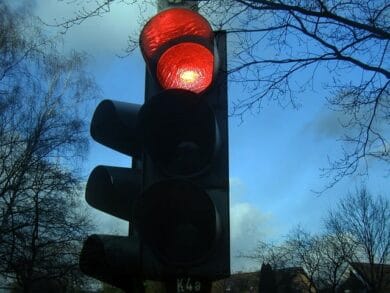Hearing you’ve failed your driving test is a big blow, especially when you know you’ve put in hours of hard work.
Sometimes it comes down to nerves and making basic errors that you haven’t made in lessons for a long time, if at all.
We asked the Driver and Vehicle Standards Agency, responsible for driving tests, for the top 10 faults that were made in Norfolk and Suffolk last year (shown in the table below), as well as looking at the latest data for Great Britain as a whole.
With these in mind, we’ve put together a quick guide with information on what the examiner is looking for and how you can avoid coming a cropper.
The 12 different faults are all from the list of skills that the examiner will be marking you against (or not, if you are fault-free!) during the test.

Junctions – observation
This is the most common fault in tests in both Norfolk and Suffolk, as well as overall nationally, and the examiner will be keeping a close eye on how well you are able to handle junctions and demonstrate key observation skills.
Our instructor Fabio Guerreiro, who teaches pupils in Norwich, said the key is to give yourself time to mentally go through what you need to do at junctions and begin processes in good time.
He said one of his pupils had a great drive on their test and otherwise picked up only a few minor faults, but failed with a serious fault as they looked to the right too late at a mini roundabout.
Mistakes that an examiner will be looking out for include only looking in one direction when emerging from a junction, not creeping carefully forward when it is necessary to make proper observations, and emerging when traffic is too close or too fast, or into the path of other traffic.
When you’re nervous, approaching a junction can feel like one of the more stressful parts of the test, so get in plenty of practice on different types during lessons to make sure you’re feeling confident.
Mirrors – change direction
Failure to check mirrors when changing direction is also a very common fault – the second most likely to occur in Norfolk, and Suffolk, and across the country in general.
Typical mistakes the examiner will be looking for include not checking mirrors before turning left or right, before changing lanes, or before or after overtaking.
Our instructors explained mirror checks can go out of the window for various reasons, including complacency and when feeling under pressure because something unexpected crops up.
Daniel Pye, who teaches in Norwich, said he had a pupil fail their test after they didn’t check their mirrors while changing lane on a roundabout. Having missed an exit and being asked to go around again, Daniel said it was in the heat of the moment and under pressure that they made a mistake they wouldn’t normally.
Ian Oxley, who delivers lessons north of the city, gives his pupils a top tip to concentrate on over-emphasising mirror checking for the first five minutes of the test until nerves have settled a little, so that you have got into the habit to continue for the rest of the test.
Control – steering

This is a fault that features less in Suffolk tests than Norfolk but is in the top 10 across the board.
While learning to control a car with the correct steering action is one of the first things you will tackle when you get behind the wheel, there are various things that the examiner will be looking out for to ensure you’re fully in control.
These include where you put and keep your hands – on the steering wheel and gear stick, and how you control the steering through turns and manoeuvres. They will also be looking out for some bad habits, like leaning on the window ledge and allowing the steering wheel to spin back after turning.
As with mirror checks, keeping your eye on how you keep control of the car may seem so basic by the time you take your test it’s not worth worrying about but, under test conditions, it’s a good idea to be conscious of keeping them in check.
Junctions – turning right
Turn right at a junction doesn’t seem to cause pupils in Suffolk too many problems, but it is one of the top 10 faults in Norfolk and across the country as a whole.
The examiner will be looking out for a number of issues, from positioning over centre lines – appropriate to the width of the road – to moving across to use lanes for turning when they are available.
Some junctions are trickier than others, with road layouts and markings that can make even experienced drivers question if they are doing the right thing. It’s important, especially when battling nerves, to assess the situation using the experience you’ve picked up through lessons and to make sure you’ve paid close attention to the road signs and markings.
If you’re not very confident with this aspect of your driving, practice, practice and more practice will help make it more second nature.
Move off – safely
In the top six faults in Norfolk, Suffolk, and nationally, being able to move off safely is obviously a crucial skill for protecting both yourself and other road users.
Learning to pull out from where you are parked is one of the first things you have to learn to be able to drive a car. But, by the time you take your test, it might be one of the basics that you fail to remember when you are dealing with nerves.
The main purpose of passing your driving test is to prove that you are a safe driver, so the examiner will be keeping a close eye on whether you look around and make observations both to the front and rear of the car before setting off.
Our instructor Rob Carey, who delivers lessons in Norwich, said he tells pupils to ensure the examiner sees them making these checks.
“I’ve had a couple of pupils fail because of not checking their blind spot effectively,” he said. “Really exaggerating the over the right shoulder blind spot check is something I ram home early on, as the examiner can only see the back of the pupil’s head when they turn that way.”
Move off – control
This is another common fault that features in the top 10 in Norfolk and Suffolk, as well as nationally.
As well as being able to move off safely, with good observation, the examiner is also checking that you are in control of the car as you do so. In particular, they could you mark you down for moving away too quickly, rolling backwards, or if you stall the engine.
Positioning – normal driving
Positioning the car incorrectly under normal driving conditions is a fault that catches out drivers across East Anglia and Great Britain.
In particular, the examiner will check that you are not too close to the left-hand kerb, or too far out towards the middle of the road, and that you aren’t moving unnecessarily in and out between parked cars.
You might think a lot about your positioning in early lessons as you get to grips with how the car reacts to your control; it’s important to stay aware and conscious of this, even as you feel much more comfortable behind the wheel.
Response to signs – road markings
During your test you of course need to demonstrate that you are able to understand and react accordingly to different road markings. These include things like lines and lane markings on the road, stop and give way lines at junctions and pedestrian crossings, box junctions, lanes for buses and cycles (and trams elsewhere in the country), and traffic calming and parking road markings.
Commonly in the top 10 faults across Norfolk, Suffolk and nationally, there are obviously lots of ways in which you could make a mistake with the examiner in the car. Examples of errors include crossing or straddling double white lines, driving in bus lanes at prohibited times, entering a box junction when the exit is not clear, or stopping over word markings like ‘Keep clear’.
A good way to stay in the habit of paying attention to road markings is to take notice of them even when you aren’t driving. Whether you’re walking down the road or a passenger in another vehicle, you can get lots of practice in by thinking about the markings you see and how you would respond to them. If you’re ever not sure what the right thing to do would be, keep a note to ask your instructor.
Reverse park – control
In your test you could be asked to demonstrate a parallel park at the side of the road, parking in a bay (either driving in and reversing out, or reversing in and driving out), or to pull up on the right-hand side of the road, reverse for two car lengths and rejoin the traffic.
Whichever manoeuvre you do, the examiner will want to know that you have enough control over the car to be able to safely get into the correct position to carry it out, take good observations throughout, and do it at an appropriate speed with consideration for other road users.
It is not a fault that learners in Norfolk most commonly pick up, but it is in the top 10 for Suffolk and Great Britain as a whole.
In particular, the examiner will be looking for things like poor clutch control, stalling the engine, excessive acceleration, poor steering, getting too close to other vehicles or hitting the kerb, or not being able to finish at an appropriate angle.
Getting manoeuvres right is down to practice, so make sure you’re comfortable with them all before test day.
Response to signs – traffic signs

Knowing your traffic signs isn’t just necessary for your theory test (or for taking part in #tuesdaytesttrivia over on our Facebook page); you of course also have to be able to apply this knowledge in real life.
This is one of the top faults in Norfolk and Suffolk, so it’s important to go into your test prepared. The examiner will want to see that you can obey traffic signs giving orders, and react appropriately to other signs, whether they are giving warnings, directions or other information.
As well as making sure you understand and know what to do with signs you see on your lessons and in mock tests, you can also get extra practice in whenever you are out and about, or a passenger in another vehicle. If you are not sure how you would react to a sign you see, look it up or ask your instructor what would be the right thing to do.
Use of speed
As you learn to drive, pressing the accelerator beyond a few miles per hour to reaching the speed limit on different types of roads goes from being a nerve-wracking to a, hopefully, more comfortable experience.
By the time test day comes around you will be ready to drive at the appropriate speed for whatever conditions you face, and it’s of course important to keep an eye on the speedometer, as the examiner will be, too.
Appropriate use of speed is not just about staying below the speed limit while driving along, but judging what is right for what is going on around you, for example other road users, the weather or approaching a hazard or junction.
Many of our pupils experience four seasons in one day in their driving lessons, but it’s important to know how you would adapt your driving in the test if faced with conditions you’ve never had before, as will happen when you drive out by yourself.
Response to signs – traffic lights

Not so much a problem with learners in Norfolk and Suffolk, but in the top 10 for Great Britain overall, you can pick up faults for reacting incorrectly to traffic lights. The examiner will be looking out for whether you stop in the right place for red lights or when it is safe to do so on amber, and set off again safely when the light is green.
Faults you might be marked down for including sailing through a red light, not stopping on amber even though it would have been safe to do so, setting off on red or amber, or setting off on green before it was safe. As a basic skill, this mistake is probably more down to nerves than lack of understanding, so keep your wits about you.
Taking it all in your stride
Interestingly, most of the faults that feature in the top 10 lists are not related to particular manoeuvres you have to demonstrate for the examiner, and which might be what you go into the test most worried about, but rather elements of ‘normal driving’.
As a good instructor wouldn’t put a pupil forward for a test unless they are ready, this suggests a lot of mistakes come down to nerves and making errors on the day that you wouldn’t normally.
However, if you make an extra effort to concentrate on keeping up your observations, maintaining good control of the car, good positioning in the road, and prepare in good time to react to road signs and markings, you can go a long way to reducing many of the common faults that occur in tests.
Next steps
Whether you have failed before, or are preparing to take your test for the first time, understanding the areas of the test in which people are most likely to make a mistake will hopefully help you to avoid some common errors.
Our blog has lots of other posts with information, tips and advice, to help you pass your test, including this one with tips on keeping your nerves at bay.
Failed your test before and want one of our five star-rated instructors to help get you across the line? Find out more about the lessons we offer around Norfolk and Suffolk.
